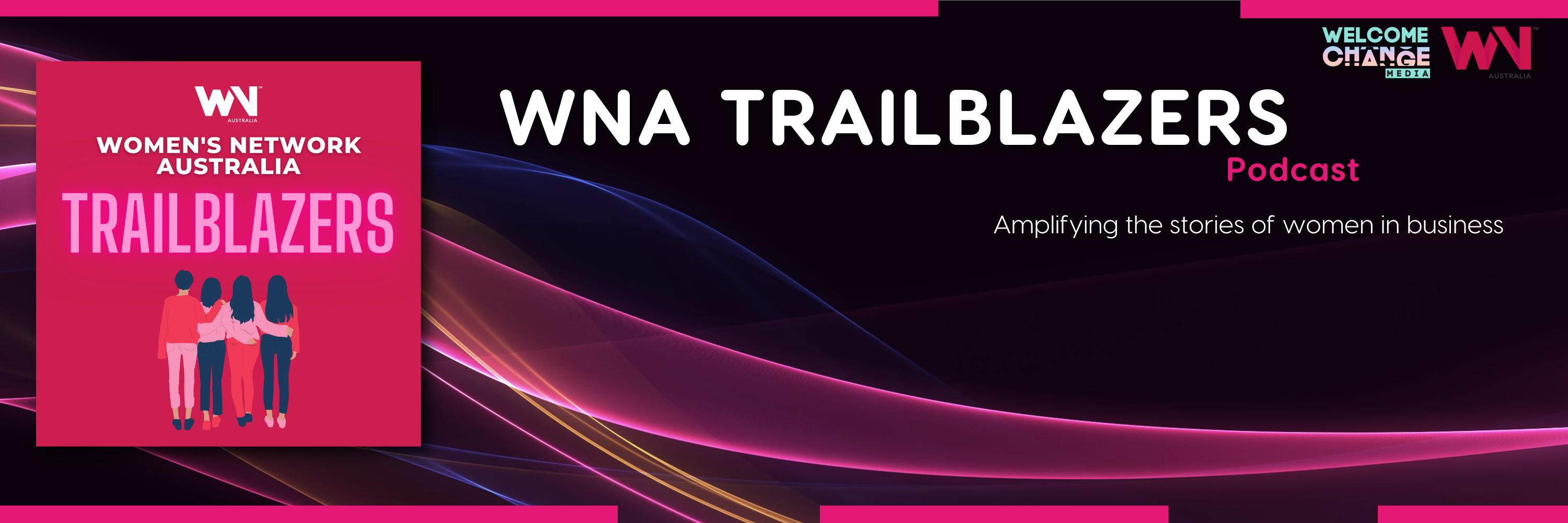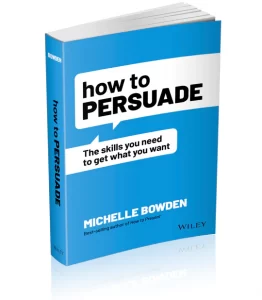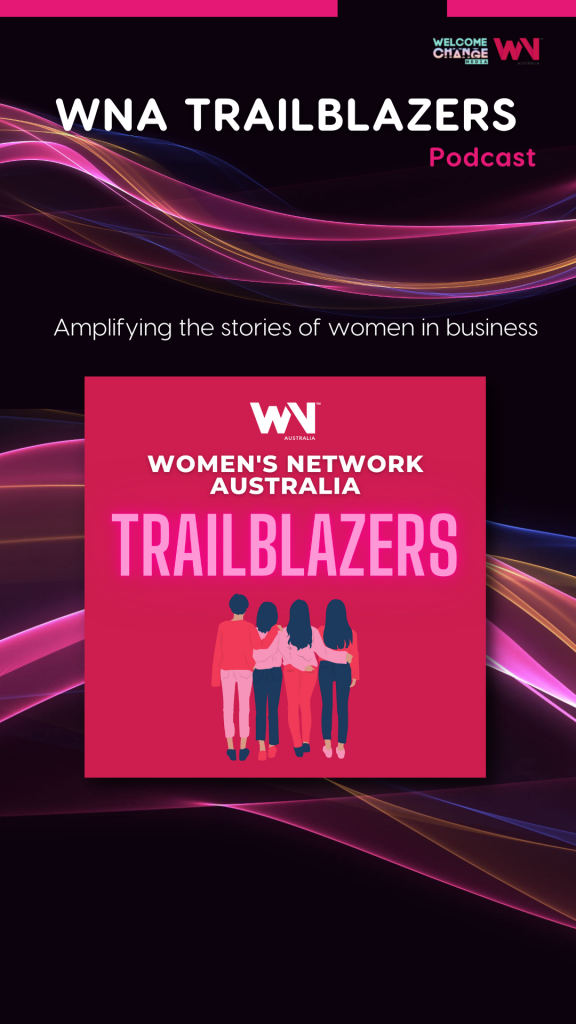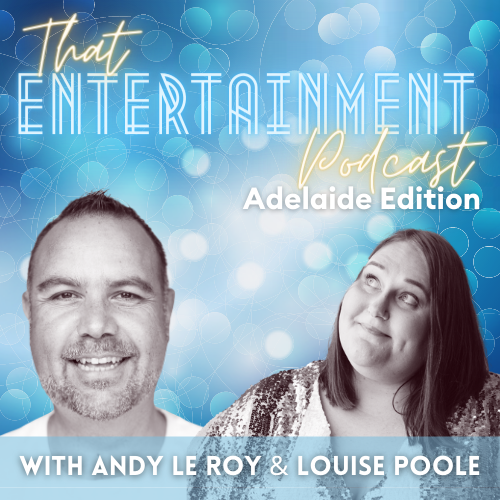
Episode 5 - How to Persuade
Michelle Bowden, Author of How to Persuade

Michelle Bowden, Author, How To Persuade

Cheryl Gray, CEO, Women’s Network Australia

Louise Poole, Podcast Partner, Welcome Change Media
Author and Trailblazer, Michelle Bowden, shares her tips with Cheryl on how to persuade.
What comes to mind when you think of Persuasion? And no, we don’t mean the popular Jane Austen classic, but another book certainly comes to mind.
You’ve probably been in a situations where you’ve seen when persuasion fails, and find yourself in a space where it can sometimes feel like it’s “persuasion vs influence” or “persuasion vs coercion”.
Who is Michelle Bowden?
Michelle Bowden talks and writes persuasion with great authority, like in her very readable book How To Persuade. Michelle knows what persuasion means and why it’s important. She’s even created a really fun model based on bird types, to help us identify what the best form of persuasion is in the real world. Are you a budgie or an owl? Maybe you’re an eagle or a peacock.
In her chat with WNA CEO Cheryl Gray, Michelle tells us why persuasion is important when it comes to communication and gives us the facts and tips, because it’s about using persuasion in an ethical way to influence, rather that thinking it’s a case of “persuasion or influence.”
We can all recognise when people’s persuasion techniques are bad. It’s those high-pressure, hard sell scenarios. This episode explores how to persuade without manipulating, and how to use your persuasion for good.


Jump to: Episode Transcript | Show Notes | Gallery | Guest | Top of Page
Show Notes
Here’s some things mentioned during the episode.
Michelle Bowden

Michelle is renowned for achieving results through learning and laughter. She has a passionate, entertaining, and highly interactive approach to her presentations that ensures behavioural change every time.
In short – she’s Australia’s authority on how to communicate persuasively for results.
– One of only 42 female Certified Speaking Professionals (CSPs) in Australia – the highest designation for speakers in the world.
– Co-creator of the Persuasion Smart Profile – a world-first, psychometric indicator that tests your persuasiveness strengths and weaknesses.
– She’s run her life-changing masterclass over 960 times over the past 23 years!
– Nominated for the past nine years for the Educator Award for Excellence (NSAA).
– International, best-selling author of How to Present – the ultimate guide to presenting live and online (Wiley), How to PErsuade: the skills you need to get what you want (Wiley) and STOP! Your PowerPoint is Killing me!


Books by Michelle:

Every day we are faced with persuasion moments where we will win or lose. The question is: How persuasive are you? Could you be ‘winning’ more of the time? Whether your aim is to secure that next big deal, or convince your manager to approve your holiday leave, or even win an argument with your friends, in How to Persuade, best-selling author Michelle Bowden shows you the research-proven techniques to master the art of persuasion in any situation.
Featuring engaging, real-world examples, inside this book you’ll discover what works, you’ll transform your weaknesses into strengths, and you’ll build your personalised plan to move people from ‘no’ to ‘yes’ – every time.

This must-read business book contains 18 massive chapters across 312 pages and shows you once and for all that anyone can be an influential presenter who imparts their ideas with confidence, clarity and influence.
Simply follow a proven system and have the right attitude. How to Present shows you once and for all that anyone – including you! – can be a highly influential presenter who speaks with confidence, clarity and influence.
Sound hard to believe? It’s easy when you follow this proven system and have the right attitude.
Connect with Michelle on LinkedIn:
Episode Transcript
Read the Transcript Online
Michelle Bowden: Most of us, when we go to persuade someone, use the approach that would work on us. [laughs] But hilariously, you’re not trying to persuade yourself. You’re trying to persuade the other person, so you can’t do what would work on you. You have to do what would work on them.
Louise Poole: WNA Trailblazers: Amplifying the stories of women in business, hosted by Women’s Network Australia CEO Cheryl Gray and me, Louise Poole, Managing Partner from podcast and content production business Welcome Change Media; proud media partner of Women’s Network Australia.
We’ve all been in that sales situation where the salesperson is doing their best to convince us that their product is the one we should buy. In their mind, they’ve listened, they’ve evaluated, and now they just need to close the deal. If only we’d comply.
Persuasion probably isn’t what you think it is, and we’ve all got our own DaVinci code that unlocks our receptiveness. If what the speaker is saying is really something that we can agree with.
Michelle Bowden has written books and regularly holds seminars around presentation and persuasion, and she’s Cheryl’s guest in this episode.
So, Cheryl, let’s talk about persuasion then. Would you consider yourself to be a persuasive person?
Cheryl Gray: Look, I think we all have to be persuasive in this day and age, whether it’s from convincing someone to buy whatever it is you’re selling, or convincing your family to eat the tea you’ve cooked. [laughs]
We’ve really gotta work hard sometimes at persuading people to take action, to listen, to consider our points of view. So yeah, look, I’d really think Michelle is onto something very important. She spent a lot of time focusing in the past on presentation skills, and in fact her book on how to present is being re-released in November.
So, her focus around presentation skills is not just how to do a good PowerPoint and how to stand correctly…
Louise: Mm.
Cheryl: But it’s really about the art of persuasion and certainly in business that is a really important skill to master.
Louise: Well, she’s definitely persuaded you to read the whole book because I’m impressed after – kind of spoiler alert coz I’ve already heard the conversation – but, uh, you have thoroughly gone through and it’s a deep discussion on persuasive techniques!
Cheryl: It’s a really well written book, I’d have to say. It’s published by Wiley and a lot of us will remember Wiley as the publishers of our school textbooks. Certainly, a lot of us had a Wiley atlas or, you know, one of those books at school. But don’t get the impression it’s a hard textbook. It’s a really engaging, easy read with lots of practical examples that I think we can all relate to in different scenarios. So yeah, I really did enjoy reading Michelle’s book and I think it’s one of those ones that you can keep and dip back into, and hone certain parts of your persuasive skills.
Louise: I think… Yeah there’s a really important distinction as well that she makes about people thinking persuasion is about manipulation, but they’re getting it wrong coz it’s actually being able to confidently convince people of your perspective.
Cheryl: Yes, and I think we also… In that same discussion, we’d start to reconsider sales. And of course, sales is a really important business skill, but often when we think about sales, we think of sort of swarmy used car salesmen and…
Louise: Mm.
Cheryl: … and trying to sell us something we really don’t want. But the art of sales and the art of persuasion is often about acknowledging that people have a problem that they need solved. And I think Michelle just helps to give us some techniques to feel comfortable in the way we present, the way we talk, and the way we hopefully solve a problem that exists. Whether it be a consumer, a buyer, or just someone that we’re talking to in everyday conversation.
Louise: I think, look, we need to hear from Michelle now then, because you’ve persuaded me. We’ve gotta listen!
Cheryl: Well, tip number one, listen to Michelle.
Louise: Oh, you got a little bit cheeky too, and started off by asking who the most persuasive person is at Michelle’s house.
Michelle Bowden: Oh, it’s definitely me. [laughs]
Cheryl: Well, I guess you have to say that, don’t you? [laughs]
Michelle: Yeah, that’s it. That’s it. But let me say that I have definitely taught those three young women to be very assertive and clear about what’s right and what’s wrong in life, so I’m very proud of that too.
Cheryl: Just tell us about how you’ve got to where you are, because whilst we are talking specifically about persuasion and the skills you need to be a persuasive individual, you’ve also done a lot in terms of professional speaking, communication and particularly presentation skills.
Michelle: I’ve always been a good presenter. I represented my school in high school at debating, and I was always the third speaker on the negative team, so I probably was the best at that. I was very persuasive from about the age of eight.
Cheryl: Wow!
Michelle: I was a very shy child. Very shy. I used to hide behind my mum’s legs and one day something happened and I just thought, this is not the way forward for me when I was eight.
It’s so weird, isn’t it? So young. At the age of eight!
Cheryl: What was the something that happened? Can you recall all this?
Michelle: Yeah, this girl was just really nasty to me [laughs] in… what would that have been, like, third grade or something like that?
Cheryl: Mm-hmm.
Michelle: And she was just so, so feral. Such a bully. She was so nasty to me, and I suddenly thought to myself, “Do you know what? I’m not gonna have any friends unless I reinvent myself.”
And I went from being a very shy, little quiet thing to being a bit more confident, and assertive, and connected to the people around me. And I made more of an effort to get out there and meet people, and talk to people, and make friends, and make people feel good, and did that from the age of eight!
When I was 22, I was working for Lend Lease, the big construction company, and I was sitting there in this job and I didn’t really love it. I hadn’t been there very long. I’d only been there about three months and I thought to myself, “Do you know what, these people in this company, they need a training department and they need a trainer and they don’t have one. So you know what I’m gonna write a proposal to the managers.”
So, I’d been to university, I’d studied a degree, and I knew how to write well from having to write so many essays at uni, and I put this proposal together at the – honestly, the gumption of me. Don’t you think, Cheryl? – at the age of 22?
Cheryl: Absolutely!
Michelle: [laughs] Saying to them, “I think you need a training department, and this is why, and I wanna be the trainer and you’re gonna have to hire me a boss, and off we go.” And you know what? They hardly deliberated. They read that proposal and they accepted it almost on the spot. They made a training department, they made me the trainer, they gave me a boss, and they paid for me to go and study a Masters of Adult Education Boom Shaka La Ka! [laughs]
Cheryl: So, in both of those cases, you were sort of at a crossroads, weren’t you? You sort of went, “Well, I could, you know, take up karate and take on this other girl who’s given me a bit of a hard time in the playground…”
Michelle: [laughs] Yes.
Cheryl: “…or I can learn to use my voice, uh, speak up, and…”
Michelle: Yes.
Cheryl: “…and become a more confident, persuasive person.” And then in… in the case of your example in Lend Lease, again, you saw an opportunity, it probably was a crossroads and you decided to take it. They’re really significant moments.
Michelle: They have been, and I think that’s probably my greatest ability – is to, I very quickly get the sense that, “Something’s not right here,” and then I make a positive change to improve it.
So, if something isn’t working, if my kid’s not happy in school, I change their school. If the client isn’t working well with me, I tell the client I’m overbooked and can’t work with them anymore. [laughs] So, I just… I do make decisions quite quickly that I’m not one to wallow around and catastrophize about the misery of it all. I’d rather take action to improve what’s going on to better the situation.
Cheryl: And then obviously out of that crossroads that you were at, you went on, as you say, very much to train yourself, but also then train others in presentation skills and how to present.
Michelle: Yeah, that’s it.
Cheryl: And you went on to write your book about how to present.
Michelle: Yes, yes.
Cheryl: And now you’ve written a book about how to persuade.
Michelle: That’s it.
Cheryl: Which is the most important skill for business? Should we be…
Michelle: That’s, you know, clients ask me that all the time, Cheryl, because they have to decide which book to buy for their people.
[both laugh]
Cheryl: and I’m sure you’ve got a fantastic two for one offer.
Michelle: It’s the same skill in my opinion. Every time we communicate, we are presenting, whether we think of it as a presentation or not. Whether we’re having a conversation, whether we’re writing a business case or an email, whether we’re pitching or tendering for something… To me that is presenting.
Presenting is any form of communication, one to one, one to few, one to many, where your objective is to change the audiences’ thinking or behaviour. So, we are always presenting. It was about – oh look, probably about two or three years into running my persuasive presentation skills masterclass, that I started running 23 years ago, And I thought to myself, “You know, there’s a niche within a niche here. What I’m good at teaching people to do is not just public speaking, which is really how to stand and deliver a message. What I’m good at is showing people how to use their skills to persuade the other person in the presentation to think, feel, or do something different to what they were thinking, feeling, or doing a minute ago.”
So, I niched within the niche into persuasive presenting. So, to me, presenting and persuasion are actually the same thing. If you are presenting well, whether it’s a eulogy, whether it’s a 21st speech, whether it’s your bridesmaid speech, whether it’s a presentation at work to get $400,000 worth of endorsement for an idea you’ve got…To me, it’s all about persuading the audience to change their behaviour or their thinking in some way.
Cheryl: And in the book, you describe yourself as having a high predisposition to persuade.
Michelle: Yes, yes.
Cheryl: Can you just explain that, what that means, and how do we know if we have it?
Michelle: I love talking about the P to P…
Cheryl: Yes.
Michelle: which is the predisposition to persuade. So, this is your care factor. Think about a dinner party and you’ve got all the friends around the table, and you’ve got that person who’s your girlfriend, who is just very noisy. [laughs]. And she’s holding court. Everybody’s listening to her, and they’re laughing at everything she’s got to say, and she’s driven to persuade you to her way of thinking.
So, the subjects we shouldn’t talk about in public, Tax, religion and sex, isn’t it? [laughs] Something like that.
Um, so someone raises climate change, for example, as an… as an issue. And that girlfriend of yours, she’s right up in her high horse and she’s telling everybody, “No, no, no! What you’ve gotta know is this. What you’ve gotta believe is this.” That person has a very high predisposition to persuade.
They don’t wanna leave the table until everybody sees it their way. And honestly, it’s… whilst it’s fun to test this, it’s not actually an indicator of how persuasive you are because, you will also know, Cheryl, that that person sometimes ends up… everyone thinks they’re a little bit silly. [laughs]
Cheryl: Yes.
Michelle: Everyone just has a bit of a laugh at them. Like, almost like they’re a bit of a joke because they’re very… they don’t believe them.
Cheryl: And sometimes they can go too far.
Michelle: Oh yes, absolutely.
Cheryl: You know, that tipping point.
Michelle: That’s it. That’s it. And they will go over the tipping point. Someone with a high predisposition to persuade will go, often, go over the tipping point. They don’t care if they’re hurting people’s feelings or if they’re talking over the top of people. They are driven to persuade you to their way of thinking. It’s very interesting, in my life, I have a very high predisposition to persuade. It’s 96%. It’s extraordinarily high. I am driven to change someone’s mind.
Cheryl: Wouldn’t it be amazing if we had a dinner party of high P to Ps? All in the room? What…what Sparks lost would fly!
Michelle: That’s it. Sparks, because everyone’s talking over the top of each other and some people aren’t listening very well. [laughs]
Now, my husband on the other hand, is like a wizard. He has a very low predisposition to persuade; it’s way below 50%. He is not driven to change your mind. He has his own opinion and he’s very firm in his convictions. He’s highly intelligent, but he is not driven to persuade you to see it his way. So, at the dinner party, my husband won’t talk up, he’ll almost melt into the background of the dinner party. And he’s very happy to laugh along with people and listen to what everyone’s saying. And then when he does speak, maybe you have this friend too, Cheryl, when he does speak, it’s like a wizard is talking and everyone is quiet and you could hear a pin drop in the dinner party.
While my husband talks, everyone sits back and nods their head and reflects upon what he is saying. So, do you see? Even though he has a very low predisposition to change your mind, he’s actually incredibly persuasive when he does talk, because he waits until he’s got something meaningful to say, and then he says it with great elegance.
It’s not how persuasive you are, it’s how driven you are to change people’s minds.
Cheryl: So, persuasion doesn’t necessarily equate to success, or success in the sense of an outcome? Or is it that our definition of persuasion is sometimes not what we think it is?
Michelle: Yes. I think most people don’t define persuasion correctly, actually. So, when it comes to the signs of influence – and we’re talking about influence here, not influencer; you can do this without a six pack, a spray tan, and a TikTok account.
There’s five ways that we go about doing it. Two of the ways are aggressive. They’re what we call forcing and directing. Two of the ways we influence are passive. That’s modelling and guiding. And then one of the ways in the middle is the assertive approach, and that is persuasion.
So often people ask me, “What’s the difference between persuasion and influence?” Well, persuasion is a subset of influence. It’s one way we go about influencing people around us. And actually, all of us oscillate on the continuum from aggressive to passive and back again, and through the assertive way, which is persuasion, all day, depending on how much you care about the outcome and how much time you’ve got.
So, the example I often talk about is you’ve got a three year old in the back seat of your car and you pull into the traffic lights and turn your head to check that they’re safely strapped in, and you notice the child has unstrapped themself and they’re having a party on your backseat of your car. What words would come out of your mouth in that moment when you noticed the child was unrestrained? You’ve got limited time, you care a lot about the outcome. You’d probably say something like, “Put your seatbelt on now!” You’d be quite aggressive, forcing and directing the child to re-click in the seatbelt.
Cheryl: That’s a really… Again, another really interesting example because sometimes we lose control… Or not lose control, but we respond before we’ve had the opportunity to think.
Michelle: That’s it.
Cheryl: So, what that intuitive, persuasive, or responsive behaviour is… is always gonna come out, isn’t it?
Michelle: That’s it. And so, you do tend to move out of persuasion and into forcing and directing when you’ve got limited time and you care a lot, because you become a bit more directive about the instructions you’re giving. So, you know you’ve got a deadline at work; the person that works for you in your team is taking too long, and you might find that you say, “Oh come on!” you know, “We’re in a hurry here. We’ve gotta meet the deadline by five. Let’s go! Let’s go!” So, you are, in that moment, you are forcing and directing.
It can be seen as manipulation when you move into either the aggressive or the passive approach to influence. So that’s something to be very mindful of. It is actually impossible to be simultaneously manipulative and persuasive. You are either manipulating, which means you are passive or aggressive. Or you are persuading, which means you are assertive, if that makes sense.
I think people do misunderstand what persuasion is. A lot of people think persuasion is manipulation and they’re actually completely the opposite thing to one another. And also, people get confused about the difference between persuasion and influence, and persuasion is simply a subset of influence. You can influence in many ways. One way is by persuading the other person. And I like to think of persuasion as where there is a measure of freedom in the decision-making process of your stakeholder, so the person doesn’t feel pushed or manipulated or coerced into doing something that they didn’t want to do.
At the end of the moment, when everyone gets on with their life, if you were to reflect, you don’t have that kind of buyer’s remorse, that yucky feeling, either that you, as the persuader used some sort of underhanded means, or the person themself doesn’t feel that they were forced or pushed into doing something that now they regret.
Persuasion is like a win-win.
Cheryl: I’m keen to understand what the relationship is between persuasion and trust in terms of influencing that outcome.
Michelle: We’re not all persuaded the same way. We’re all, as humans, we’re all different people with different needs. So, there are four main approaches to persuasion. And I suppose the funny thing about persuasion is that most of us, when we go to persuade someone, use the approach that would work on us. But hilariously, you’re not trying to persuade yourself. You’re trying to persuade the other person. So you can’t do what would work on you. You have to do what would work on them.
And one of the approaches is called the commanding eagle. And the commanding eagle is someone who has an innate drive to persuade by establishing personal authority. In other words, they are the expert. When you see someone like that walk into a room, they have a presence about them. They are confident, believable, and to your question, they are very trustworthy because they have the runs on the board. And when they talk, you can just sense this huge amount of experience.
If you’ve ever seen an eagle, in its courting phase in the sky… Eagles don’t just, when they’re courting, don’t just soar around on the thermals, the wind currents up in the sky. Eagles perform a spectacular plummeting courtship ritual where they tumble and free fall out of the sky. They own the space. They own the room when they’re in a workplace or even in a social situation. And yeah, so trust is what it’s all about [laughs] because you just can sense that they know what they’re talking about.
Cheryl: The friendly budgie! Tell us about the friendly budgie.
Michelle: [laughs] Yeah, if you don’t mind me just quickly explaining at the risk of everyone thinking I’m full of pop psychology…
[both laugh]
So, I’ve been incubating on my nest for over 20 years, trying to work out how to help my clients that are pitching for big 700 million dollar deals. How to help my executives pitch to their board, how to help executives pitch to their teams… And I just… I wanted to help these people be more persuasive. And I think step one of becoming more persuasive is “know yourself.” How are you best persuaded, and therefore what approach comes naturally to you when you are trying to persuade all the people around you?
So, we created a psychometric assessment tool, something called the Persuasion Smart Profile, with a team of statisticians and psychologists in the UK, and it effectively helps you to assess where you are strong and where you are weak when it comes to the four approaches. So that’s step one.
The step two is to be able to pick it in other people. And you know, we’ve all done all these psych tests in our lives. I just feel that there’s a lot of them around. And if in the persuasive moment, because you’re under a bit of time pressure or you’re stressed, it might actually be too hard to work out, “What is the preference of that person that you need to persuade in this moment?”
And that’s why we came up with these birds. The four birds have characteristics that ideally map to the characteristics of the four persuasive approaches. So, we have the wise owl, the commanding eagle, the friendly budgie, and the captivating peacock. And if you think about all of the characteristics of those four birds, yes, they do in fact ideally correlate with those four approaches to persuasion.
Cheryl: You’ve also looked at persuasion and these types of personality traits or personalities in team settings.
Michelle: Yes.
Cheryl: If we are in an organisation where we want to be persuasive as a group, how important is it to have more than one bird in your flock?
Michelle: The way this works is that whilst all of those four approaches may be of value to us, to all of us, we tend to have a preference for one, two, or even three of them. So, you won’t just be a budgie or just be an eagle. You are likely to be a combination of a variety of the different birds.
So back to the steps for becoming persuasion smart, step one is “Know yourself.” What are your preferences and how are you most likely to be persuaded, and therefore, what’s your strength when you go to persuade others?
Step two is having a deep sense of what is required by the other person, and then being able to flex or adapt your approach to meet their need. What do they need? Give it to them.
Step three is to build your persuasive muscles. So, this is really the answer to your question, Cheryl. To build your persuasive muscles so that you are actually strong in all four of the bird types.
We all should be strong in all four. The reason for that is that much of the time that we are persuading, we are actually just going through life and not even realizing that what we just did was persuade. I mean, I was at a… I was presenting at a conference yesterday and there was a girl at the table who didn’t want sparkling water when we went for lunch.
And the way she explained to the waiter that she wanted still water, in my opinion, was a persuasive moment. The waiter looked discombobulated that someone would want still water. It was sparkling water in the jug, and that was what the waiter wanted to give everyone. They were not interested in the fact that still water could be an option.
Do you see? Even in that moment you are persuading someone.
Cheryl: Yes.
Michelle: And at the time you’re not thinking to yourself, “Oh, I’m in a persuasive moment coz I want still water.” So, if you can, there are actually 10 actions for each of the four birds, which equals 40 actions. And I know that sounds like just too much to care about.
The good news is that really a lot of the behaviours that we need to get better at are very easy things to do immediately. You don’t even have to learn them, you can just start doing them. For example, we should all say “because” more often; it’s the number one persuasive word in the world. We should not say the word “but” when we are communicating with people, coz it activates the mammalian brain, puts them into a fight flight response, and then they argue with us.
We should put numbers, not bullet points when we send an email or put slides up, because owls care about the logic of an argument. Need numbers, not bullet points. Do you know what I mean? There are some simple things that we can all do right now to be instantly more persuasive, and that’s what it is to sort of flex your persuasive muscle so that you’ve got more of the skills and can therefore persuade more people more of the time.
And then step four of becoming persuasion smart is adapting or flexing your style to give the other person, or the other people, what they need. And most of the time we’re not persuading one person at a time; we’ve got 10 people in the meeting and they’ll be all a variety of different combinations of birds in the bird cage.
So, if the more we can really bring those 40 actions into our skill set, and sort of unconsciously competent at all of those things, then without even thinking we’re gonna be persuasive.
Cheryl: Super conscious of my use of the word “but” from now on.
Michelle: Oh, yes.
Cheryl: Because it obviously…it does sort of trigger, “Ah, well, there’s an alternative here. I won’t follow along.”
Michelle: It negates everything you just said and it causes conflict. So, one of the best things you can do if you’re in conflict with someone is avoid the use of the word “but.” So, for anyone that’s listening to this, if you have just listened to what Cheryl’s saying and thinking, “Yeah, I agree with Cheryl. I really wanna get rid of ‘but’”, the best way of getting rid of it is to replace it with another word. And you want an inoffensive, un-emotive, joining word like “and” or “so.” It’s not correct English to say “and” or “so.” The thing is we’re not trying to speak correct English here. We’re trying to speak persuasively. So, we forgo the correct English, which is the word “but” or “however,” and we replace it with the incorrect English, which is “and” or “so,” and in that way, we diffuse the conflict out of the conversation or the email.
Cheryl: Clearly, I’ve spent too many years writing rather than speaking, and I use my rules of writing rather than my use persuasive speaking.
Michelle: That’s it. Proper English.
Cheryl: Which is really interesting, isn’t it?
Michelle: That’s it. Yeah, I’ve got a daughter in year 12, and of course if she didn’t say “but” she’ll get a lower mark in her advanced English essays. She’s gotta say “but.” We’re not trying to speak correct English. when we try and speak persuasively.
If I said to you, “Cheryl, um, you look so great in that frock today. It just really suits you. The colour is vibrant. You look terrific. You just look so healthy and well. It’s just a great choice for you. But, I’d love to see you in a navy one.”
Cheryl: That’s right. It’s a real downer to have that “but” at the end.
Michelle: [laughs] and in a performance appraisal for anyone that’s listening, “You’re so amazing. You did this. You met your KPIs. You achieved X result for our company. But, we need you to focus on this now.” Oh dear! [laughs] That person’s looking on seek.com if you performance manage them like that.
Cheryl: Fantastic tips, and there’s plenty more in the book, obviously, but… [laughs] and now you’ve just… you’ve just got me going. I can’t stop.
Tell me about storytelling and where does storytelling fit into our persuasive toolkit?
Michelle: Mm. Everyone needs stories. Owls, eagles, budgies, and peacocks. And the story needs to be adapted to the needs of whoever you are persuading. Owls needs stories that include case studies, external proof that the message you are conveying is to be believed.
Eagles need the story to be about you and your achievements and your credibility. Your runs on the board.
Budgies love stories that make everyone feel good, where there’s a positive outcome. Something was sad and then something lovely happened at the end of the story, and now we all feel terrific. [laughs]
And peacocks need the story to be emotionally evocative – a roller coaster. “I was worried, I was optimistic. I was relieved. Then I was joyful then I was jubilant.” [laughs] What are the emotions you’re taking them on? Peacocks need the emotional highs and lows.
There is a model for telling a good story in business, and it’s a very simple storytelling model. It’s called the Magic Formula Story and it comes from Dale Carnegie, who wrote that very wonderful and famous book How to Win Friends and Influence People. And the formula is simply this – Incident, Point, Benefit, I.P.B.
Incident is where you tell the story. So, you know Cheryl, you’ve probably got friends who are good storytellers. I’m sure you are too.
And the person tells the story, tells the story, tells the story, and you’re saying, “Get to the…?”
Cheryl: [laughs]
Michelle: Point! So, point is the second part of it. Incident, Point. And the point relates to the story as you told it. It’s about the people and the characters in the story. And then the third part of it is the benefit, coz we’ve all had people tell stories to us.
And at the time, especially at work, we’re thinking, “Oh, that was a great story, but what the hell has it got to do with anything we’re talking about here? Did they just waste my time?”
Cheryl: Perhaps, controversially, are we…
Michelle: Yes, please.
Cheryl: Are we overusing the storytelling model?
Michelle: Cheryl, you are my spirit animal. Honestly.
Cheryl: [laughs]
Michelle: I completely and utterly agree with you. I do think that there’s an over-focus on storytelling. As a presentation skills trainer who runs a very life changing and amazing training course every single week of my life, I rarely teach storytelling in it. And the reason is there are so many other things you’ve gotta get good at. If you wanna be an amazing persuasive presenter, that storytelling isn’t even it.
I do still think you need to follow the Incident, Point, Benefit. My great philosophy is that a technique exposed is a technique lost. If you are so obviously telling a story that people can even track, “Well, that was the incident, now that was the point, and now here comes the benefit,” then I suggest that you need to practice your storytelling a little bit more, and you might want to read my chapter on some of the important things about storytelling, like “keep it short.”
You’re taking too long. If people are starting to track for the process, your story story’s taking too long.
Cheryl: They’re sitting there going, “Wait for it. Wait for it. Here it comes.”
Michelle: [laughs] That’s it! “Wait for it.” That’s so funny. The other thing is, I think we need to really be connected to our stories. And sometimes it’s just so obvious, isn’t it, that the person’s, “Insert story here.” [laughs]
Cheryl: Yes.
Michelle: And you don’t wanna do that.
Cheryl: Yes.
Michelle: The other thing you definitely don’t wanna do is warn the audience. “Let me tell you a little story.” Oh, my God! Everyone groans and goes, “Please don’t!”
Cheryl: Yes.
Michelle: “Please don’t tell me your story!” [laughs] Especially if it’s you and me in the audience, Cheryl!
Cheryl: These are terrific tips and you can get more tips and incredible information from Michelle’s book How to Persuade: The Skills You Need to Get What You Want. But Michelle, where else can people contact you or find out more? I know you have a lot on your website and your blog. Can you just tell us where?
Michelle: Yeah. I’ve got a lot of really wonderful free content on my www.michellebowden.com au.
I’m very active on LinkedIn, posting all sorts of fabulous tips on presenting and persuading, weekly. So, I’d love to hear from listeners if you’ve found this helpful or if you have any further questions. It’s my pleasure to make you more persuasive!
Cheryl: Michelle, thank you so much for your time and we look forward to the re-release of How to Present and look forward to talking to you again!
Michelle: Oh, it’s just been such a delight to talk to you, Cheryl. You are so good at this!
Louise Poole: Michelle was a great find for you to get Cheryl. Uh… BUT, I feel like we’ve both been called out on our use of the word “but”, um, since then.
Cheryl: AND we have been called, out exactly right, Louise. I did not realise how many times I used the word “but” until Michelle pointed it out in that conversation, and you know, I really struggled after that to actually come up with sentences that didn’t start with the word “but!”
Louise: [laugh] That was so interesting though, because I didn’t consider that. But, yeah, the fact that it’s a negative…It negates the thing that you just said… If you could see me – mind blown emoji. That’s my face right now.
Cheryl: I agree. I agree. And I, look, I was feeling really terrible, I’d have to say, when she kept pointing that out.
But what I also liked was she quite rightly pointed out that the use of the word “and” in the written form, would be incorrect. So, I’ve probably grown up spending all of my time very much focusing on writing and correct use of language in the written form. But, of course when we’re trying to persuade someone in the way that we are talking… so, very different style and totally different set of rules. AND now we need to use the word “and” more often.
Louise: AND we could check out a copy of Michelle’s book for more information!
Cheryl: We absolutely could, and I think it’s a great tool, not just for people in business, but for anyone. And as I said, it’s a really easy read. She’s done an amazing job and yes, definitely worth picking up.
Louise: So, Michelle’s book is called How to Persuade: The Skills You Need to Get What You Want, and we can find more information about Michelle at michellebowden.com au. And Cheryl, how can we find more information about Women’s Network Australia?
Cheryl: I’m glad you ask Louise, as you always do! You can find out more information about Women’s Network Australia at our website, womensnetwork.com.au, or on all your favourite social media platforms. And of course, if you’re listening to this podcast, you’ll know exactly where to find more episodes!
Louise: And don’t forget to leave us a review and give us a thumbs up!
Cheryl: Please do. We’ve been really impressed by the feedback from the initial episodes, so we love to hear from listeners and we wanna hear from them about the feedback that they get from sharing information about these trailblazing women.
Louise: And the other thing is, if people have suggestions on trailblazers that they’d like to hear us chat to, I think send that through!
Cheryl: Absolutely, Louise! Drop us a line at wna@womensnetwork.com.au. We love hearing about empowered women and women in business and trailblazing women. So yes, feel free to email suggestions and you never know one of them could be you.
Louise: Next time on WNA Trailblazers, how’s your physical self-care strategy?
Mel Kettle: If you are stuck in stuck mode or in survival mode or on that hamster wheel of achieving, there’s ways out. And I certainly know when I was in survival mode, I just thought that I had to endure this forever. Really, really grateful that I had an excellent doctor. I went to see him one day because I was having chest pains multiple times a day, and he said to me, “Actually don’t know how you’re walking around! I’ve never seen a blood pressure this high on somebody your age. If you don’t make some major changes, you’ll probably have a stroke before you turn 30.”
Louise: Leadership Communication specialist, Mel Kettle chats to Cheryl about the importance of identifying things early and taking action.
Women’s Network Australia Trailblazers amplifying the stories of women in business. Follow us from this podcasting app and be the first to hear new episodes.
Excited to share your story with our network? Follow the “contact us” link in the show notes to let us know. Women’s Network Australia Trailblazers is a Welcome Change Media production.













